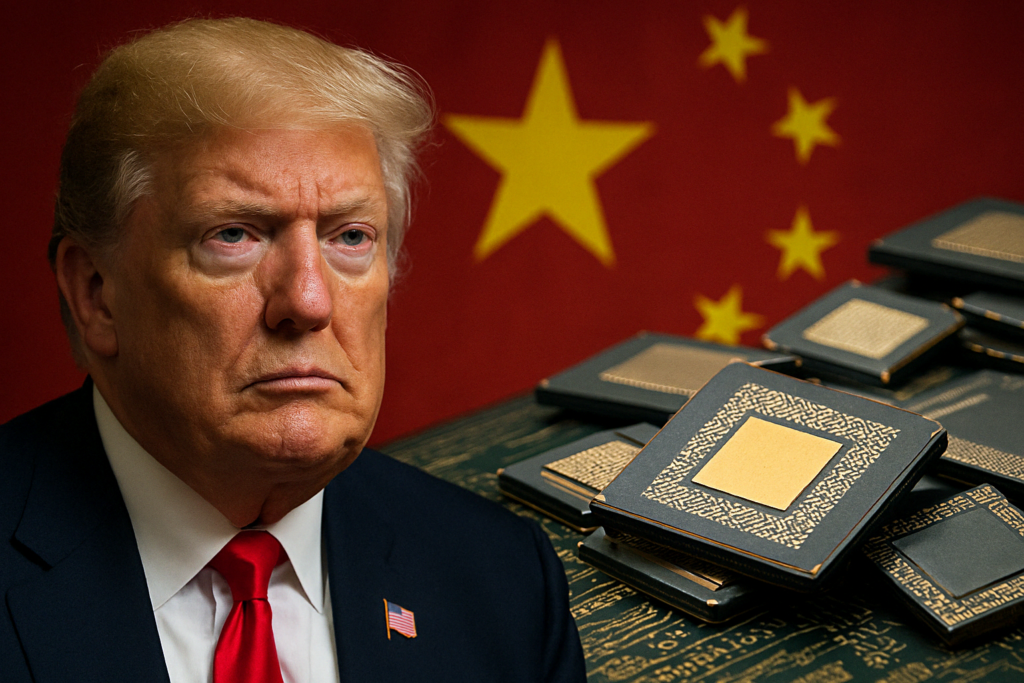The U.S.-China trade war has escalated; this time, semiconductors are at the heart of the battle. President Trump’s tariffs on Chinese-made chips are shaking up the tech industry in ways that could disrupt the entire global supply chain. Semiconductors are essential for everything from smartphones to AI systems, and the trade conflict is driving a wedge between the U.S. and China, creating challenges for companies like Tesla, Nvidia, and Apple. As the global chip market grapples with rising tariffs, companies seek ways to mitigate the damage and ensure their operations remain competitive.
What’s Happening & Why This Matters
The U.S. government has imposed new tariffs on Chinese-made semiconductors as part of an ongoing effort to challenge China’s economic power. These tariffs, which can be as high as 25%, target semiconductors and other technology components, driving up the costs for companies that rely on chips made in China. The new measures follow the Trump administration’s efforts to restructure the global supply chain and reduce U.S. dependence on foreign-made technology products.
Nvidia, a leader in AI hardware, has responded by investing in U.S. manufacturing to mitigate the effects of the tariffs. The company is building new semiconductor factories in Texas in collaboration with Foxconn and Wistron. These factories are designed to help Nvidia reduce its reliance on Chinese-made chips and maintain its competitive edge in the global AI supercomputer market. Nvidia CEO Jensen Huang emphasized the importance of these new plants for supporting the company’s AI goals while avoiding tariffs that could harm Nvidia’s pricing and profit margins.
The Trump administration’s tariff war with China also impacts companies that depend on high-tech components for smartphones and computers. However, smartphones and computers were exempted from the new tariff rules, meaning products like Apple’s iPhones are unaffected by the latest tariff rules. This has relieved consumer tech companies, but the continued uncertainty surrounding semiconductor tariffs is still an unanswered concern for the global tech market.
The situation is complicated for Tesla. The electric vehicle company heavily relies on semiconductors to power its vehicles. As Tesla faces increasing pressure from local manufacturers in China, these tariffs could further limit the company’s ability to compete in the Chinese market. Even though Tesla’s vehicles are built in Shanghai, rising tariffs could still affect its ability to source the chips needed for its self-driving technology.
The trade war also has a lasting impact on the global semiconductor market, as manufacturers in China and other regions face higher costs to produce chips and tech components. The ripple effects are being felt by many industries — from consumer electronics to automotive and AI — all rely on advanced semiconductor technology to power their products.
The Global Impact
The U.S.-China tariff war is not just about trade relations. It is fundamentally reshaping the global tech ecosystem. Semiconductors are critical in many of today’s technologies, from smartphones to data centers and AI infrastructure. As the U.S. seeks to reduce its reliance on China for tech production, it could alter the global chip supply chain and lead to the reordering of manufacturing bases worldwide.
For Nvidia and other AI companies, the chip tariffs represent an opportunity to invest in U.S.-based production. However, they also raise questions about whether domestic production can meet the growing global demand for semiconductors. Companies like Intel, which have significant operations in the U.S., will also be affected by changes in the global supply chain, especially as the demand for AI-powered hardware grows.
As semiconductors become more critical for developing AI, cloud computing, and consumer electronics, the U.S.-China trade conflict will likely influence the global tech ecosystem for years. The trade war is pushing companies to rethink their international strategies, whether relocating manufacturing or seeking new sources of chips outside of China. The semiconductor market is a key battleground in this conflict, and the winners will shape the future of AI and technology innovation.
Strategic Re-alignment: Manufacturing and Innovation
Nvidia’s decision to establish new manufacturing plants in the U.S. directly responds to the growing tariff pressure. The company is joining a growing trend of tech firms shifting production to avoid tariffs and increase their control over supply chains. For Nvidia, the goal is to ensure that it can continue to lead the AI chip market without facing the same pricing pressures that would result from Chinese tariffs.

In addition to manufacturing adjustments, Nvidia is also making strategic investments in AI research and supercomputing technologies. These investments are designed to maintain the company’s leadership in the fast-growing AI sector, where it faces increasing competition from China, which is rapidly developing its AI capabilities. However, despite these efforts, the U.S.-China tariff war remains a significant source of uncertainty. Nvidia and other U.S. tech companies must continue adjusting their strategies in the face of shifting global trade dynamics.
The trade conflict has created a precarious situation for tech companies as they try to balance global expansion with domestic production. Companies that rely heavily on global supply chains, like Tesla and Apple, may need to reassess their reliance on Chinese manufacturing to avoid tariffs and maintain profitability. This growing tension between the U.S. and China is changing global technologies and will affect the industry’s future.
TF Summary: What’s Next
The U.S.-China tariff war has thrust semiconductors into the spotlight, with major companies like Nvidia and Tesla reevaluating their strategies to adapt to new trade policies. As tariffs impact chip production, companies turn to U.S.-based manufacturing and restructure their supply chains to maintain their competitive edge. While Nvidia’s new factories in the U.S. provide a potential buffer against the rising tariffs, the global tech industry will need to find new ways to navigate the changing trade environment. The U.S.-China trade war is far from over, and its long-term effects on semiconductors, AI development, and global tech markets will be felt for years.
— Text-to-Speech (TTS) provided by gspeech


